The Yamaha YZ250F dirt bike, even decades after its initial release, remains a significant model in the world of off-road motorcycling. For enthusiasts seeking the perfect balance between agile handling and potent engine performance, the YZ250F set a new benchmark. In 2001, when this model was first introduced, Yamaha arguably achieved the “Holy Grail” of dirt bikes, offering a machine that rivaled the handling of a 125cc two-stroke while delivering the enhanced power of a 250 class engine. While finding a brand-new 2001 model might be a challenge today, understanding the impact and features of this bike is crucial for anyone appreciating the evolution of dirt bike technology and considering used options.
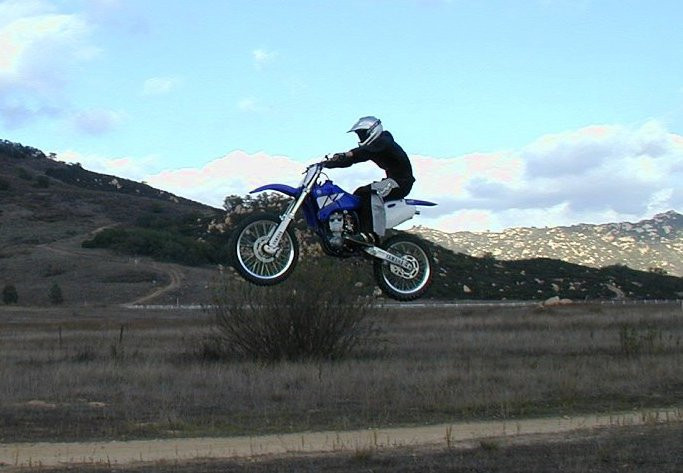 Seventeen year old test rider Alex Edge showcasing the Yamaha YZ250F's capabilities with a jump.
Seventeen year old test rider Alex Edge showcasing the Yamaha YZ250F's capabilities with a jump.
Handling Prowess: Nimble and Precise Like a 125, But Better
One of the most lauded aspects of the Yamaha YZ250F dirt bike is its exceptional handling. Test riders consistently reported that it felt even more nimble than a 125cc two-stroke, a class known for its superior maneuverability. While perhaps not quite as feather-light as a 125, the YZ250F surpasses 250cc two-strokes in weight and offers a level of agility on both the track and trail that is truly remarkable.
The key advantage of the YZ250F in handling comes from its superior traction. The 250cc four-stroke engine delivers power in a way that enhances grip during both acceleration and deceleration. This four-stroke engine characteristic allows the tires to bite into the terrain more effectively than a comparable two-stroke, providing riders with increased confidence and control in various conditions.
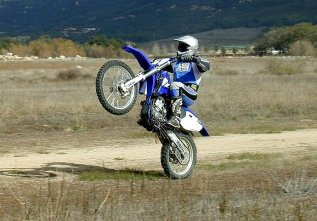 Yamaha YZ250F dirt bike side view showcasing its design and features.
Yamaha YZ250F dirt bike side view showcasing its design and features.
Cornering, a critical aspect of dirt bike performance, is where the YZ250F truly shines. It outclasses even 125cc two-strokes in cornering ability. Whether navigating berms, flat turns, rutted tracks, or smooth surfaces, the YZ250F exhibits superb cornering capabilities. Its stable and predictable nature empowers riders to choose and maintain any line through a corner with confidence. This level of cornering precision was, at the time, typically only associated with smaller 80cc bikes, highlighting the YZ250F’s groundbreaking handling dynamics for a 250cc machine.
Engine Performance: Fast, Tractable, and Highly Usable 250cc Power
Traditionally, 250cc four-stroke engines were often perceived as slow, especially when compared to their two-stroke counterparts. However, the Yamaha YZ250F shattered this stereotype. It delivered an engine that was not only tractable and usable, characteristics common in four-strokes, but also genuinely fast. This combination was revolutionary for the time and remains a key reason for the bike’s enduring appeal.
The YZ250F boasts a significantly broader powerband than a 125cc two-stroke. Furthermore, its torque output far exceeds that of a 125. While the peak horsepower might be comparable to a fast 125cc two-stroke, the YZ250F’s advantage lies in its ability to deliver usable power across a much wider RPM range. This translates to less gear shifting and a more forgiving engine, making it easier for riders to maintain momentum and power out of corners.
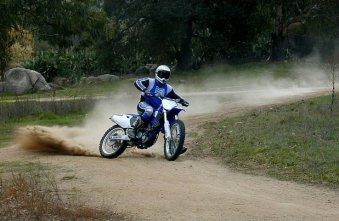 Side profile of the Yamaha YZ250F dirt bike highlighting its suspension and exhaust system.
Side profile of the Yamaha YZ250F dirt bike highlighting its suspension and exhaust system.
Yamaha Suspension and Chassis: Stability with Cornering Agility
The Yamaha YZ250F dirt bike inherited the renowned Yamaha motocross chassis characteristics, known for blending straight-line stability with exceptional cornering agility. While testers noted some headshake through whoops during the initial test period, this was likely attributable to not yet fine-tuning the suspension settings. Yamaha forks, known for requiring a break-in period, typically become more plush after a few rides where they are worked through their full stroke.
The stock suspension components on the YZ250F were considered sufficiently capable to clearly demonstrate the bike’s exceptional handling traits. While the ideal suspension setup might differ from that of Yamaha’s two-stroke models or the heavier YZ426, the base settings provided a solid foundation for excellent performance. Further refinement and tuning could optimize the suspension for individual rider preferences and specific track conditions.
Transmission and Braking: Refined and Effective
The YZ250F features a smooth and reliable transmission. Once engaged in first gear and in motion, gear changes are seamless and unobtrusive. Test riders reported no instances of missed shifts, highlighting the transmission’s positive engagement and overall performance.
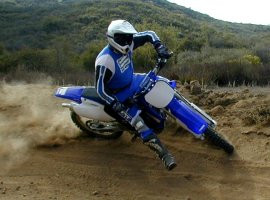 Yamaha YZ250F dirt bike angled view showing front brake and wheel details.
Yamaha YZ250F dirt bike angled view showing front brake and wheel details.
Braking performance on the YZ250F is enhanced by sharing its front braking system with other models in the Yamaha YZ range of that year. The incorporation of a larger rotor and redesigned master cylinder resulted in excellent braking power and feel. The relatively light weight of the YZ250F further contributes to braking efficiency, allowing for confident and controlled deceleration.
Reduced Rider Fatigue: Ride Longer and Stronger
One of the standout benefits of the Yamaha YZ250F, as highlighted by experienced riders like Doug Dubach, is its ease of riding and reduced rider fatigue. It was considered the least tiring motocross bike of its time. The combination of smooth power delivery and effective engine braking allows riders to conserve energy and maintain a faster pace for longer durations. This means riders can complete more laps and feel fresher at the end of a riding session compared to other motocross bikes.
Jumping and Off-Road Versatility
The YZ250F excels in jumping, exhibiting a neutral feel in the air and softer landings compared to 250cc two-strokes, feeling more akin to a 125 in this aspect. Its superior torque and traction when exiting corners translate to improved launch over jumps, especially on tracks with short run-ups.
Beyond the motocross track, the YZ250F also proves to be a capable trail bike. The tractable and smooth power delivery, significantly less abrupt than open-class four-strokes, is well-suited for off-road riding. For dedicated trail use, opting for a wider, 18-inch rear tire could further enhance its off-road capabilities, providing improved traction and compliance over varied terrain. While the stock transmission ratios are optimized for motocross, riders focusing on trails, enduros, or desert riding might find the wider-ratio transmission from the WR250F model to be a more suitable choice.
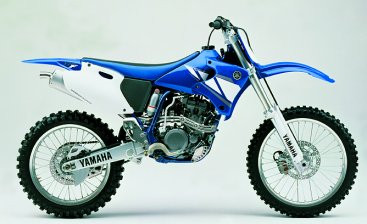 Studio side view of the Yamaha YZ250F showcasing its overall aesthetics and design.
Studio side view of the Yamaha YZ250F showcasing its overall aesthetics and design.
Who Will Appreciate the YZ250F? Everyone.
The Yamaha YZ250F dirt bike holds universal appeal. Both seasoned open-class riders and those accustomed to the agility of 125cc bikes will find enjoyment in riding the YZ250F. Its balanced performance characteristics suggest that many riders could potentially achieve faster lap times and maintain higher speeds and strength throughout longer motos compared to other machines. While professional racers might still seek the ultimate power of a 250 two-stroke or open-class four-stroke for top-level competition, the YZ250F provides a remarkably accessible and high-performing platform for a wide range of skill levels and riding preferences.
Conclusion: The Enduring Legacy of the Yamaha YZ250F
The Yamaha YZ250F dirt bike represented a pivotal moment in motocross and off-road motorcycle development. Yamaha’s early commitment to developing high-performance, lightweight four-stroke technology for motocross and enduro applications proved visionary. The YZ250F delivered on its promise, offering a revolutionary blend of handling and power that redefined the 250cc class. Even today, the legacy of the Yamaha YZ250F continues to influence dirt bike design and remains a sought-after machine for riders who appreciate its groundbreaking performance and balanced capabilities.
